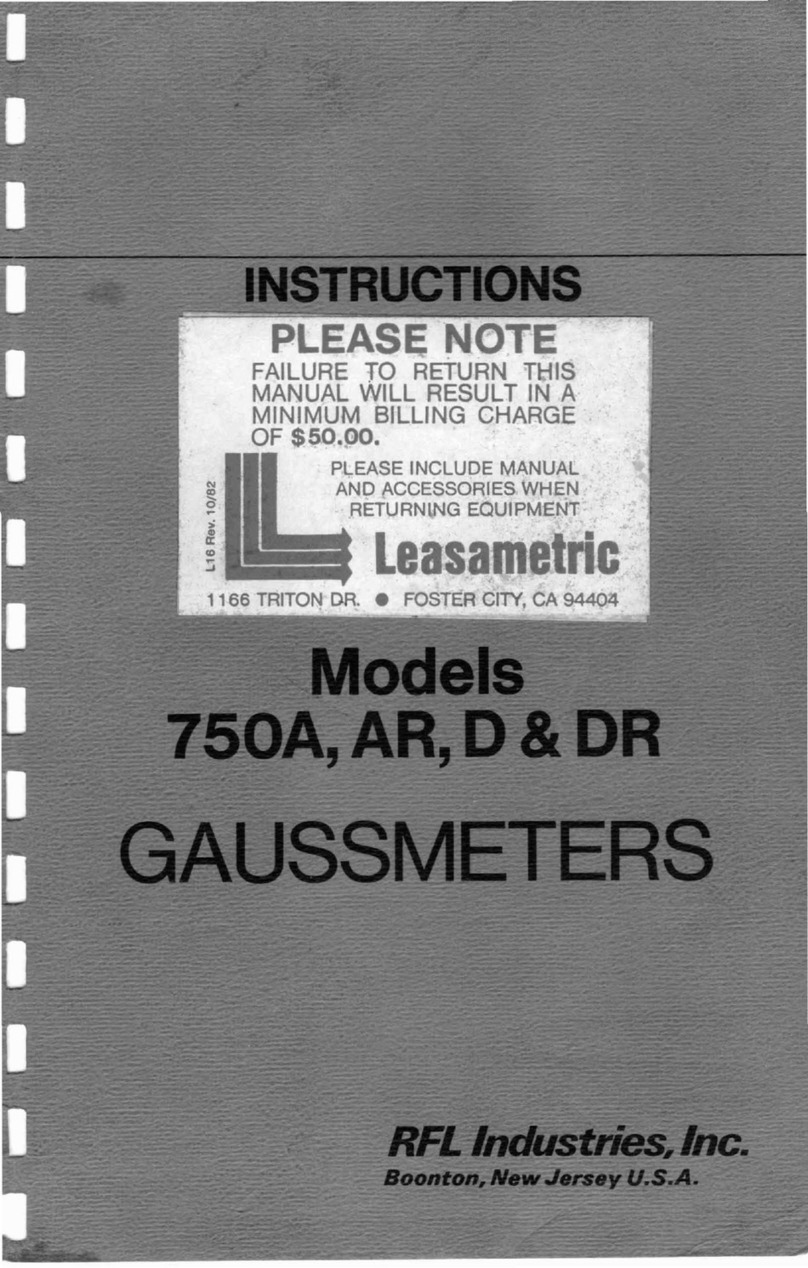
I.1
Ii
Lii
5
6
For 230-volt operation, the case should be opened, Fl should
be replaced with a fuse rated for 0.125 ampere, and S2 should be
moved to its 230-volt position, after which the instrument may be
powered.
OPERATION
(1)
Connect the Hall probe to its socket on the rear panel. The
location will be seen on Figure 3.
(2)
Set all switches on the front panel, Figure 3, to their out
position. Connect the instrument to its source of power, depress
the POWER switch, and allow the instrument to warm up for ap-
proximately ten minutes before continuing.
(3)
Depress READ/CAL button to CAL.
(4)
Depress 10K/CAL switch to CAL.
(5)
Using the 0-10 scale on the front-panel meter, adjust the
CAL potentiometer so that the meter reads the number which is
stamped on the body of the probe. The instrument is now
calibrated to the characteristics of the individual probe used.
(6)Move CAL/READ button to READ by depressing to release it.
(7)
Depress the 30-gauss (0.003 tesla) range button.
(8)
If a zero-field chamber is available, place the active end of
the probe in the chamber. If no chamber is available, orient the
probe in space so that the earth's magnetic field causes the
minimum deflection on the meter, Then, in either case, adjust the
NULL control for zero on the meter. The instrument is now ready
for use.
It is advisable to recheck the zero condition periodically.
Although under normal conditions it is stable, there is always the
possibility that either the NULL or the CAL control may have been
moved inadvertently.
The tip of the probe is color coded to indicate polarity of the
magnetic field. When the red-marked side of the flat probe, or the
front end of an axial probe is pointed toward a magnetic pole
which attracts the North-seeking end of a compass needle, the
polarity-indicating lamp marked N will be illuminated.
Although every effort has been expended to make the Hall
probe as rugged as possible, it should be remembered that the Hall
element is a fragile component. Use care when handling the
probe. Do not force it into narrow gaps, or apply twisting or bend-
ing forces while the probe is in the confines of a gap. A properly
handled probe will last many years, but carelessness can destroy
the element in a few seconds.
12
Chapter V
PROBES
The Models 904 and 904T use Hall-effect probes for measuring
flux density. RFL has nine standard Hall-effect probes available for
use with this instrument. Questions on choice and application of
probes and search coils, as well as questions on unusual applica-
tions, may be direct to RFL's Magnetics Engineering Department.
Flat or Transverse-Field Probes
The transverse Hall-probe measures magnetic fields perpen-
dicular to its flat surface. RFL flat probes are supplied in thickness
ranging from 0.015 inch to 0.039 inch. The 0.025 and
0.039-inch probes are enclosed in rugged fiberglass/epoxy
shields to provide maximum protection for the sensitive Hall ele-
ment. All flat probes incorporate a pencil-slim handle and semi-
flexible leads from the element to enable use in a wide variety of
applications. A lightweight, five-foot cable is standard with all flat
probes.
Axial Probe
This configuration is used to measure fields parallel to the probe
handle, such as solenoidal fields. The Hall element is encapsulated
in epoxy and the handle is rigid for several inches beyond the tip.
Various sizes are available. The axial probe, because of its tip con-
struction, is generally less subject to accidental damage than flat
probes. Care must be exercised, however, not to allow the flat
face of the tip to contact abrasive surfaces where any motion is
involved. The Hall element is located only a few thousandths of an
inch behind the face and could be damaged if undue pressure is
placed on it.
Tangential Flat Probe
The tangential probe is similar to the flat probe with the main
difference that the element is placed as close to the edge of the tip
as possible. The flat-probe element is centered between the out-
side edges of its enclosure. This construction puts the element in
close proximity to the outside edges of the enclosure. Care must
be taken, therefore, that the probe will not be subjected to rough
handling.
13




























